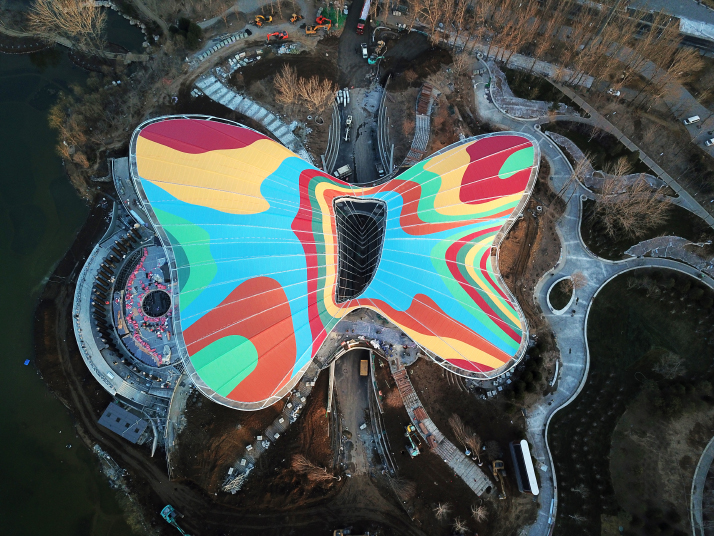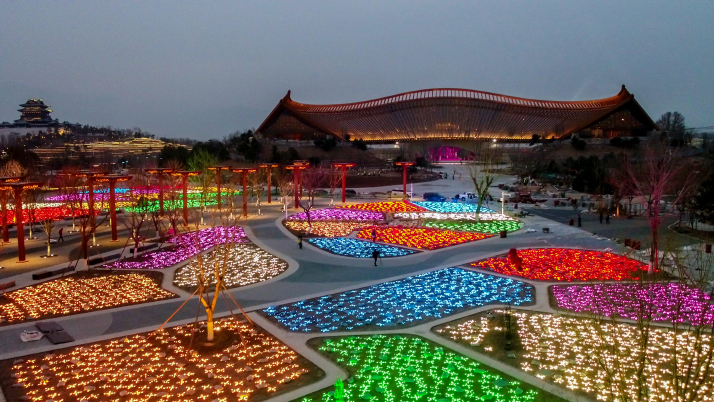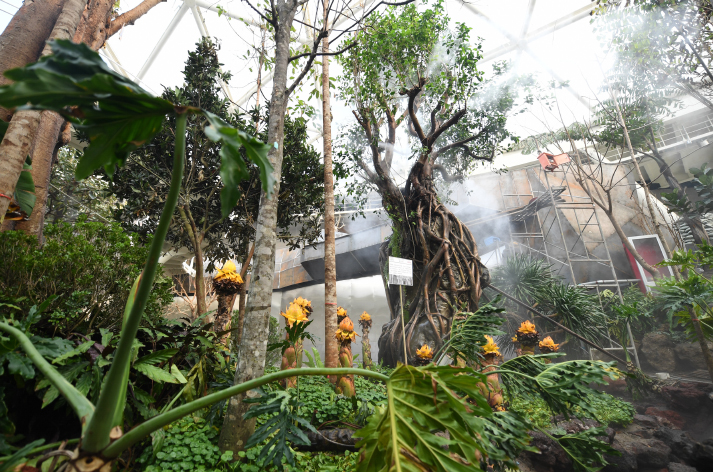| Editor's Choice |
| Ready to Bloom | |
| The International Horticultural Exhibition 2019 is ready to welcome visitors with innovations and achievements | |
|
|
 The Performance Center at the site of the International Horticultural Exhibition 2019 on March 27 (XINHUA)
As trees burgeon and flowers blossom in Beijing, choreographing a spring chorus of colors and aromas, the site of the International Horticultural Exhibition 2019, sprawling at the foot of the Badaling Great Wall, is finally ready to burst into bloom. The expo, to be held in Yanqing District of Beijing, is scheduled to kick off on April 29, and last for 162 days until October 7. The preparation work has gone well and Beijing will do a remarkable job in presenting this expo to the world, said Tim Briercliffe, Secretary General of the International Association of Horticultural Producers, on April 13, while visiting the expo site. The organization, founded in Zurich, Switzerland, in 1948, states its mission as to "reignite and uphold an appreciation of plants that we believe is a basic human instinct." In 2012, it conferred on the Chinese capital the right to host the 2019 expo. The main roads and pavilions for the expo have been completed, so has the planting of trees, shrubs and most ground vegetation, according to the Beijing International Horticultural Exhibition Coordination Bureau (BIHECB), which is coordinating the preparation work. Moreover, nearly 4,000 operation and service personnel have been on duty at the expo site since April 1, and a trial opening was held on April 13 to test the reception capacity of the event.  The China Pavilion at the International Horticultural Exhibition 2019 on March 29 (XINHUA)
Plants in place "As an international event representing the highest level of horticulture, the Beijing Expo 2019 will showcase the latest flora species, horticultural technologies, ideas and achievements from around China and the world," said Feng Yaoxiang, Director of the Department for Trade and Investment Promotion under the China Council for the Promotion of International Trade, a co-organizer of the expo, in a recent speech. He also said the event will promote the harmonious coexistence and common development of humans and nature and the Beautiful China initiative. According to the BIHECB, more than 1,200 plant species from home and abroad will be displayed at the 503-hectare expo site. To create a picturesque scenery in different seasons, 50,000 trees and 120,000 shrubs have been planted, said Zhou Jianping, Executive Director General of the BIHECB, at a recent press conference. They have been carefully selected so that they complement the plants indigenous to the area to create splendid vistas, he said. Located in a mountainous area in suburban Beijing, Yanqing has an average elevation of more than 500 meters above sea level. Its weather is relatively cool, with temperatures that can drop to below 0 degree Celsius at night. In 2016, plant experts working for the expo started to search for cold-resistant and beautiful flowers and plants that could last through spring, summer and autumn in Yanqing. They also improved the soil at the expo site to help plants thrive. After three years of painstaking exploration, the plant research team has carefully cultivated and improved upon selected flora species so that they bloom earlier and fade later. A plant that grows at an altitude between 3,000-5,000 meters above sea level on the Qinghai-Tibet Plateau, the Meconopsis florindae Kingdon-Ward, was one of the selected species. In March 2017, the Beijing Botanical Garden sowed the seeds of the plant in the garden, which grew and blossomed for the first time in plain area, impressing the botanical community at home and abroad. In addition to domestic species, many foreign species have been chosen. Yu Xuebin, Deputy General Manager of Beijing Urban Construction and Landscape Greening Group, said, "We have chosen more than 1,000 foreign flower varieties that can adapt to Beijing's climate and have high beautifying value, so that visitors to the expo can enjoy exotic flowers and plants from all over the world." Seeds from overseas first went through a customs quarantine process, then were sown and cultivated in laboratories before being transplanted to test fields in Yanqing to make sure that they could survive in local weather. While cold-resistant flora varieties have been chosen for outdoor areas, tropical varieties, some of which are very rare, have been introduced into the expo's Plant Pavilion, which is a gigantic greenhouse. A huge banyan tree, which was painstakingly transported from southwest China's Yunnan Province, stands about 20 meters tall and weighs 20 tons. Banyans and insectivorous plants will be displayed in a zone showing how plants struggle to survive by strangulating each other or eating insects, said Ding Changfeng, who is in charge of the pavilion. According to Ding, plants in this pavilion are arranged into five zones. A mangrove forest will be featured in a zone demonstrating plants' ability to adapt to and survive adverse climates. Other zones will exhibit how plants disperse their seeds, evolve and morph into different shapes. Some plants have been chosen because they carry special significance. In a garden featuring Shaanxi Province, apple and pomegranate trees, as well as grapevines, were planted along a winding trail symbolizing the Silk Road. These three fruits are believed to have been introduced into China through the ancient road. Along with flowers, vegetables will also be featured at the expo. "Since April 5, three planting bases in Yanqing began to supply vegetables to the expo's vegetable garden. As of April 10, a total of 60,000 pots of vegetables had been transplanted," Zhang Hongyuan, head of the vegetable project of Beijing Dongsheng Seeding Industry Co. Ltd., told the media. Moreover, the expo site is shaded by nearly 50,000 trees that are native to the area, said Zhou. The site used to be a riverside forest park, where trees such as poplar, locust and weeping willow grow. "At the expo site, we can see big trees everywhere—on the banks of the Guishui River, at the foot of Tiantian Mountain and on Qingyang Island," he said, adding that these old trees and newly planted trees together will provide shade.  Some rare plants in the Plant Pavilion of the International Horticultural Exhibition 2019, which will open on April 29 (XINHUA)
Paving roads While preparation for the expo is in full swing, Yanqing is dressing up its streets for the occasion. The trees on Yankang Road near the expo site have been pruned. Major roads leading to the expo site have been re-marked and road signs added to guide tourists to the expo site, said Hao Yi, an employee of Beijing Municipal Bridge Maintenance Management Group Co. Ltd, who is in charge of maintaining a section of the road in Yanqing. During the expo, roads near the site will be classified into core, key and general roads. Xing Yajie, an employee with the Yanqing Highway Branch, said that during the expo, the frequency of road cleaning will be increased from the current twice a day to seven times a day for core roads and four times a day for key roads, and will remain at twice a day for general roads. Road cleaning will mainly be carried out by machines, supplemented by human workers. Located on the outskirts of Yanqing, the site chosen for the expo was initially very dirty, said Zhang Haifeng, head of Yanqing Town. Zhang Lianhai, a villager living nearby told the press, "In the past, many structures along the roads were built illegally for various purposes, such as recycling garbage and selling auto parts. Sundry items were piled up on roadsides. They were not only dirty and messy, but also obstructed traffic." In March 2017, Zhang Haifeng said the district began to dismantle the illegal structures, pave more roads, plant trees and shrubs, and build roadside parks. Now, with a clean and beautiful environment, the district is ready to welcome guests from all over the world. The expo is expected to receive 16 million visits, averaging 100,000 per day, according to the BIHECB. Measures have been taken to transport this large amount of people in and out of the area. On the first day of 2019, the Yanqing section of the Beijing-Chongli Expressway was opened to traffic, offering an alternative to the congested Badaling section of the Beijing-Tibet Expressway. In addition, Suburban Railway Line S2 in Beijing, dubbed "train to spring" because of the scenery along the line during the blooming season, will operate at an increased frequency during the expo, Zhou said. Moreover there will be eight direct bus lines connecting the expo site to various locations in downtown Beijing. He also said that a number of parking lots have been set up around the expo site, which offer more than 19,000 parking spaces. Gearing up services "We are ready! We will greet every visitor with enthusiasm, professionalism and the best services," Li Ying, captain of the Badaling Great Wall Volunteer Service Team, told the media. On April 13, the expo site opened its doors to about 30,000 people, primarily local Yanqing residents, for a test run. Some 555 volunteers answered inquiries and worked as guides and translators for visitors. According to the BIHECB, 24,000 volunteers will provide services at the expo, including about 20,000 stationed at the expo site and approximately 4,000 in Yanqing. Recruitment for college volunteers to serve at the Beijing expo's opening ceremony was completed, with volunteers currently receiving training, said an executive with the BIHECB. "They will showcase Yanqing people's hospitality and courtesy to guests from home and abroad," said Lin Jun, Secretary of the Yanqing Committee of the Communist Youth League of China. At the trial opening, nearly 4,000 staff members in 12 teams were on duty at the site, including operation, management, reception, tourist services and security. Visitors tested services including transportation to and from the expo site, food and beverages as well as shopping. Moreover, to ensure safety during the expo, the district recently conducted a drill on providing emergency rescue assistance in a simulated stampede. During the drill, nine people were "injured," three seriously, two moderately and four mildly. Staff members on site evacuated the general public, and brought the "injured" to safe areas; rescue teams then arrived, offering first aid and transferring the "injured" to different local hospitals. "Through this drill, we got familiar with the entire process of rescuing and treating potential stampede victims. The treatment process went smooth, the rescue was timely and the follow-up treatment was appropriate," said Gou Jingming, chief of the Medical Affairs Section of Yanqing District Health Commission. He said the next step will be to rectify the problems found during the drill and enhance the coordination ability of various departments. Yanqing has also renovated six "food streets" to offer catering services and improved the quality of accommodations, which altogether can hold more than 30,000 people at any given time, Zhou said. "We will complete all the preparation work and strive to host a unique, wonderful and unforgettable expo," Ye Dahua, Deputy Director of the BIHECB, said. Copyedited by Rebeca Toledo Comments to wanghairong@bjreview.com |
|
||||||||||||||||||||||||||||
|
